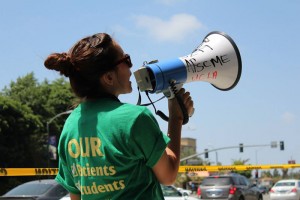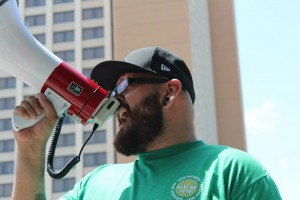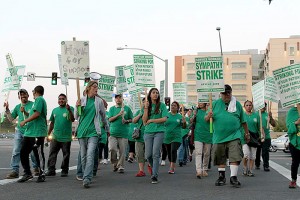Worker’s Strike Costs UC $20 Million

Over 750 patient care workers went on strike in front of the UC Irvine Medical Center in Orange last Tuesday and Wednesday, demanding the University of California to improve medical center staffing levels, stem the utilization of a temporary “per diem” workforce and provide fairer compensation.
Beginning 4 a.m. Tuesday morning, local chapter members of the American Federation of State, County and Municipal Employees (AFSCME) 3299 union — comprised of employees from UC campuses and facilities — reported to the picket line instead of their work shifts and occupied the corner of City Drive and Medical Center Drive to participate in the statewide strike.
Jorge Serrato, an AFSCME 3299 organizer, acknowledged that even though the labor movement has recently faced challenges in terms of organizing and initiating strikes, this particular action was extremely successful.
“I was extremely exhilarated to see so many of the co-workers out there in the struggles against the cuts that UC wants as well as the shortstaffing,” Serrato said.
Exceeding Serrato’s original expectations of approximately only 500 strikers, the actual number of workers that went on strike represented over 50 percent of the Medical Center’s staff. Only a handful of staff remained at the Gottschalk Medical Plaza, located on the UC Irvine campus; as a result, the Plaza was completely shut down. According to Serrato, Medical Center clinics and telemetry units were shut down.
Totaling $20 million, according to Vice President of Systemwide Human Resources Dwaine Duckett, the University’s costs for the strike encompass not only loss of revenue but also hiring expenses for strikebreakers (whose wages are higher than that of regular employees) that include meals, airfare and hotel accommodations.

Serrato said that that money could have been spent on improving staffing conditions and providing a fairer compensation for workers. The patient-worker ratio at UC medical centers is currently twice that of other hospitals, said Serrato. He continued to say that under the current two-tier pension system, which is effective July 1 and requires current long-time employees to pay an additional 1.5 percent of wages, most workers will end up retiring into poverty.
Although it was a difficult decision for workers to walk out on their patients, Serrato said that the intent of the strike was to advocate for more staffing to provide quality care for patients. A patient protection task force designated a certain number of employees that would cross picket lines and return to work in the case that patients were not being taken care of.
In addition to sacrificing patient care, another aspect that contributed to the workers’ dilemmas regarding whether to strike or not was the paycheck-to-paycheck basis on which many of them subsist. A strike fund, maintained through an allocation of 25 percent of member dues, paid striking workers $70 for one day of the strike; the other day was unpaid. The Orange County Labor Federation, consisting of over 93 unions, helped contribute to a special hardship fund for those who suffered undue hardship for striking.
UCI students also took time out of classes in order to show solidarity with the striking workers. ASUCI Executive Vice President-elect Melissa Gamble urged that students should be more involved with workers’ campaigns because the cuts the workers face parallel the cuts currently being made to students’ educations.
“These issues are affecting the University, and the workers are part of the University,” Gamble said. For the upcoming academic year, she plans to add a labor branch to ASUCI to work with the labor unions on campus in educating students and initiating calls to action around worker issues.

“My role as a student was to provide solidarity,” said Lisa Lei, a UCI student organizer who chanted and marched across the Medical Center campus alongside workers. She described a scene during which police officers attempted to intimidate and pull over protesters walking in the rear flank of a mass street crossing. Serrato maintained that the protestors were not doing anything illegal.
Lei recently organized a meeting with Vice Chancellor of Student Affairs Thomas Parham in order to address students’ desires to improve work conditions, in which Parham claimed his hands were tied.
“We know he has the power to advocate for the workers’ rights but he chooses not to,” Lei said.
Serrato said that AFSCME 3299 does not anticipate UC responding to their demands. Rather, he claimed that the University will make employees feel as if the strike was not effective.
“We will continue to have a lot more actions unless UC comes to the negotiation table,” Serrato said.
[Source]: New University


